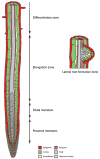Getting to the root of plant biology: impact of the Arabidopsis genome sequence on root research
- PMID: 20409273
- PMCID: PMC2967761
- DOI: 10.1111/j.1365-313X.2010.04129.x
Getting to the root of plant biology: impact of the Arabidopsis genome sequence on root research
Abstract
Prior to the availability of the genome sequence, the root of Arabidopsis had attracted a small but ardent group of researchers drawn to its accessibility and developmental simplicity. Roots are easily observed when grown on the surface of nutrient agar media, facilitating analysis of responses to stimuli such as gravity and touch. Developmental biologists were attracted to the simple radial organization of primary root tissues, which form a series of concentric cylinders around the central vascular tissue. Equally attractive was the mode of propagation, with stem cells at the tip giving rise to progeny that were confined to cell files. These properties of root development reduced the normal four-dimensional problem of development (three spatial dimensions and time) to a two-dimensional problem, with cell type on the radial axis and developmental time along the longitudinal axis. The availability of the complete Arabidopsis genome sequence has dramatically accelerated traditional genetic research on root biology, and has also enabled entirely new experimental strategies to be applied. Here we review examples of the ways in which availability of the Arabidopsis genome sequence has enhanced progress in understanding root biology.
Figures



References
-
- Aida M, Beis D, Heidstra R, Willemsen V, Blilou I, Galinha C, Nussaume L, Noh YS, Amasino R, Scheres B. The PLETHORA genes mediate patterning of the Arabidopsis root stem cell niche. Cell. 2004;119:109–120. - PubMed
-
- Armengaud P, Zambaux K, Hills A, Sulpice R, Pattison RJ, Blatt MR, Amtmann A. Ez-Rhizo: integrated software for the fast and accurate measurement of root system architecture. Plant J. 2008;57:945–956. - PubMed
-
- Benfey PN, Schiefelbein JW. Getting to the root of plant development: the genetics of Arabidopsis root formation. Trends Genet. 1994;10:84–88. - PubMed

